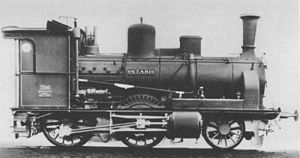Saxon IIIb V
| IIIb V DR series 34.79 |
|
|---|---|
| Numbering: | 796-798, 504-518 DR 34 7901-7902 |
| Number: | 18th |
| Manufacturer: | Saxon machine factory , Chemnitz |
| Year of construction (s): | 1889/1892 |
| Retirement: | 1923 |
| Axis formula : | 1 'B n2v |
| Gauge : | 1,435 mm |
| Length over buffers: | 13,996 mm |
| Height: | 4,150 mm |
| Total wheelbase: | 4,550 / 4,950 mm |
| Empty mass: | 37.2 t |
| Service mass: | 41.0 t |
| Friction mass: | 27.8 t |
| Wheel set mass : | 13.9 t |
| Top speed: | 75 km / h |
| Driving wheel diameter: | 1,560 mm |
| Impeller diameter: | 1,230 mm |
| Control type : | Allan |
| Number of cylinders: | 2 |
| HD cylinder diameter: | 650 mm |
| LP cylinder diameter: | 420 mm |
| Piston stroke: | 560 mm |
| Boiler overpressure: | 12 bar |
| Number of heating pipes: | 180 |
| Heating pipe length: | 3,500 mm |
| Grate area: | 1.82 m² |
| Radiant heating surface: | 8.0 m² |
| Tubular heating surface: | 89.0 m² |
| Evaporation heating surface: | 97.02 m² |
| Tender: | sä 3T 9 |
| Brake: | Air brake type grinder Westinghouse air brake (retrofitted) |
As genus IIIb designated Royal Saxon State Railways four-coupled Schlepptender locomotives for passenger service.
history
After the success with the composite locomotives of type VIb V , corresponding locomotives were also procured for passenger train service. The Sächsische Maschinenfabrik developed a composite locomotive based on the design of class IIIb . In the years 1889 and 1892 a total of 18 copies of the IIIb V were built for passenger train service. Since the machines apparently did not really prove themselves, no further procurement was made.
The Hartmann Fab had the first 3 machines. No .: 1574, 1575, 1576; Track number 796, 797, 798 (1889), the other Hartmann Fab. No. 1829 consecutively until 1843, track numbers 504 to 518 (1892)
The Deutsche Reichsbahn took over some of the locomotives after 1920. Only two machines were given the new road numbers 34 7901 and 34 7902 in 1924.
Constructive features
The locomotives had a long boiler made of three sections with a semicircular ceiling, which was drawn in between the frame cheeks in the fire box area. Two non-suction injectors were used to feed the boiler .
The steam engine was designed as a two-cylinder compound drive with internal all-control. The high pressure cylinder was on the right, the larger low pressure cylinder on the left. The second coupled axle was driven.
The driving axles were firmly mounted in the frame, the leading running axle was designed as a Novotny-Klien steering axle .
The locomotives were brand new with pneumatic brakes of the Schleifer type, but these were only effective for the train. Westinghouse air brakes were later installed on all locomotives. The locomotives were coupled with sä 3 T 9 tenders of the Saxon design.
literature
- Fritz Näbrich, Günter Meyer, Reiner Preuß: Lokomotivarchiv Sachsen 1.transpress VEB Verlag für Verkehrwesen , Berlin 1983
- Erich Preuß , Reiner Preuß : Saxon State Railways . transpress Verlagsgesellschaft, Berlin 1991, ISBN 3-344-70700-0 .

